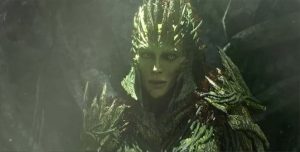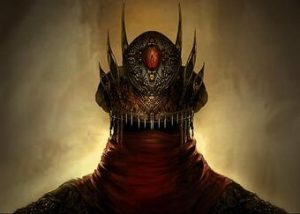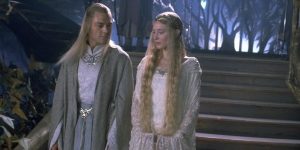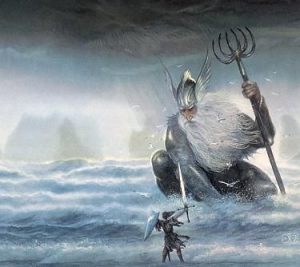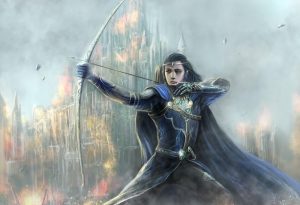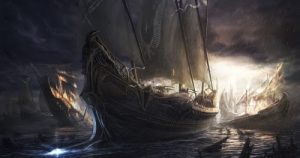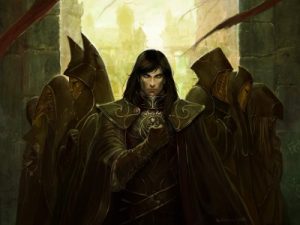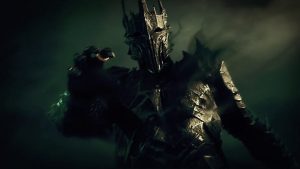It’s been a while since we’ve talked about my favorite topic, The Lord Of The Rings and all things Tolkien (it really hasn’t, since I somehow manage to bring it up in most completely unrelated posts, but that’s beside the point), or since I’ve written a “top ten” list like the ones I did sometime back in March, where I discussed things I wanted to see in Amazon Prime’s upcoming adaptation of J.R.R. Tolkien’s writings on the Second Age of Middle-earth, as well as things I didn’t want to see, and characters I hope the series will handle with the utmost care. In the meantime, the Tolkien fandom has found other things to argue about – most recently the topic of sexuality in the Professor’s works, something I will address later in this post, and which was in fact the inspiration for this post. After seeing how shocked and outraged a portion of the Tolkien fandom was in response to the news that nudity and sexuality might be present in the Amazon Prime series, I asked myself: what other things might similarly shock them, if it’s mature content they’re opposed to? Things straight from the Tolkien canon, things that the Professor himself sketched out in detail or tantalizingly hinted at, and which will now have the opportunity to be realized onscreen?
Of course, this list will only be dealing with shocking events and themes of the Second Age of Middle-earth, which is when the Amazon Prime series will be set (no, it’s not really The Lord Of The Rings, and I still don’t understand why they haven’t given us some indication of what the actual title will be). The Second Age just so happens to be the second darkest era in Middle-earth’s history (the First being, both figuratively and, until the creation of the sun and moon quite literally, the darkest), which means there’s a great deal of strange, terrifying, controversial or just uncomfortable things for Amazon to draw from for their adaptation. And now, without further ado, let’s get into it.

10: Different Magic. Let’s ease into this and start out fairly tame, with something that Amazon doesn’t necessarily have to include, but definitely should if they can find a way to do so naturally without alienating a massive part of the Tolkien fandom. In Tolkien’s assorted early writings on the Blue Wizards of Middle-earth, he briefly mentioned something that has always fascinated me and has always intrigued me because of how it seemingly challenges the loose rules of his soft magic system. “I fear that they failed…,” he wrote of the two Wizards, “and I suspect they were founders or beginners of secret cults and ‘magic’ traditions that outlasted the fall of Sauron.” Tolkien would later rewrite the story and have the Blue Wizards play an active, heroic role in bringing about Sauron’s downfall secretly from the east, but the idea of the duo spreading the knowledge or understanding of magic throughout Middle-earth is almost too irresistible to pass up on – even if Tolkien put magic in quotes, and clearly didn’t intend for it to mean real magical power like that possessed by Gandalf or the Elves. We’ve never seen magic used quite to this extent before in Middle-earth, certainly not with regards to cults or occult practices. And considering how Tolkien’s magic system is often used as the gold standard for soft magic systems in fantasy, it could be risky to explore this in too much detail – though it could be rewarding because it would give the show a chance to explore uncharted territory.

9: The Valar. As with occult magic, this has the potential to be both a good idea and a bad idea, depending on who you ask. Most hardcore fans know and love the Valar, but more casual fans might be weirded out by the reveal that Tolkien’s world comes with an entire pantheon of gods, goddesses and other minor deities – like the sun, and the moon…and Gandalf. In the semi-biblical narrative of The Silmarillion, the presence of the Valar feels very natural and I would argue it’s no different with the Second Age – but I’m just one person, and I have previously seen some quiet backlash to the idea of the Valar ever physically appearing. Some simply feel like it’s too radical a departure from the Middle-earth that most people know from The Lord Of The Rings, while others specifically don’t like The Silmarillion because of the gods and goddesses and other somewhat religious elements of the story. Amazon will have to include the Valar either way, because they’re critical to the story, but I’m interested to see what the reaction will be from the fandom. Personally I’d be thrilled.

8: The Burning Of The Entwife Gardens. Let’s get a little more specific now. In the cinematic Middle-earth franchise thus far, the most explicit act of desolation we’ve seen has been a single vision of a ruined Shire in the Mirror of Galadriel, and the wreck of Dale by dragon-fire in The Hobbit. But we’ve never seen anything on the scale of the torching of the Entwife gardens near the end of the Second Age. The Entwives cultivated a tranquil land east of the River Anduin, which unfortunately fell directly on Sauron’s warpath as his armies returned from defeat in Eriador to Mordor. In an attempt to deplete the approaching Last Alliance’s resources, he torched the Entwife gardens, and the Entwives themselves disappeared from recorded history. Were they burned? Enslaved and put to work in Mordor (in which case, that will be even more disturbing content to watch out for)? Or did they escape to happier lands? Whatever their fate may have been, watching their gardens be uprooted and scorched will be shockingly brutal enough. Not unpredictable, but definitely the stuff that season finale cliffhangers are made of.

7: Celebrimbor, Gil-galad And Anarion’s Deaths. The Second Age is filled with a lot of very violent deaths. Nobody knows this better than Celebrimbor of Eregion, the Elven smith who forged most of the Rings of Power and was later betrayed by his partner and confidante, Annatar – who turned out to have been Sauron in disguise all along. Sauron and his orc armies attacked Eregion with the hope of locating the Three Rings that Celebrimbor had made for the Elves: they pillaged the city without any luck, and eventually Sauron captured Celebrimbor and tortured him mercilessly for information. Celebrimbor refused to relent, and so, of course, he was killed. But Sauron wasn’t content with just murdering one of the last of the Fëanorian bloodline. No, he also horribly mutilated the Elf, shot him full of arrows, and had his body hung from a flagpole and carried into battle like a banner by his orc army. That’s straight out of Game Of Thrones right there, and is almost certain to land the show a TV-MA rating no matter what. As for Gil-galad, last High King of the Noldor, he was apparently burned alive by the fiery heat of Sauron’s hand during their duel on the slopes of Mount Doom. And Anarion…well, he got his whole head bashed in by a rock thrown from the parapets of Barad-dûr, killing him and crushing the crown of Gondor. I don’t know which of these three fates was the worst, but all will certainly be graphic and stomach-churning onscreen.
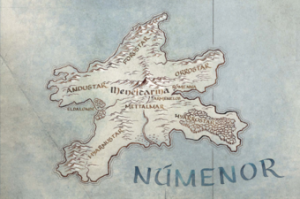
6: Death And Mortality. Speaking of death, it’s actually one of the major recurring themes throughout the Second Age – and when the series begins to tackle the subject of Númenor and their relationship with death and mortality, that’s when it’s going to abruptly steer away from the realm of fantasy and into disturbing, cynical, psychological horror. For many fans of The Lord Of The Rings, it might come as a shock to realize that Tolkien’s world isn’t always escapist entertainment, but can be horrifyingly realistic when it needs to be. It’s in Númenor where this will surely be most apparent, as the island kingdom’s long-lived people slowly begin to lose their famous longevity and wither away: in desperation, they cling to life but fall into madness, chaos and a frantic search for a cure to death, or an antidote to their fear – which some of them find in Sauron’s evil, or in the nihilistic worship of the dead. They turn away from the wisdom of the Valar and the Elves, and descend into an abyss of their own making (and ultimately into the very real abyss beneath their island. Too soon?). It’s really grim.

5: Commentary On Imperialism. Tolkien was no fan of the British Empire’s global expansion, and his works reflect that: much of the trouble in Númenor first begins to emerge after the island kingdom starts occupying lands in Middle-earth across the sea, starting wars with the native peoples there and bringing back riches to fuel and fund ever more conquests. For our own sake, I hope that any violence against the native peoples of Middle-earth will be shown as it is – an unjust brutality – and not glorified or normalized. Some will complain that it’s politicizing Tolkien’s work or “pushing an agenda”, but they will be purposefully ignoring the fact that Tolkien’s work is already very political and itself pushes a very anti-imperialist agenda. The Númenóreans are also responsible for deforesting almost the entirety of Middle-earth’s western shore from the Elven kingdom in Lindon all the way to Harad at least, but probably even further. Remember in The Lord Of The Rings, when Treebeard the Ent laments the vast forests that once covered the earth? Yeah, Númenóreans tore them all down and used the wood to build ships. If you’re not shocked by that, you probably should be.

4: Human Sacrifice. Just a little bit more graphic violence, don’t worry. When the Dark Lord Sauron arrived in Númenor and began playing on the growing fears and prejudices of the Númenórean people to increase his own power, he also had a plan to try and make Middle-earth great again – a plan which involved sacrificing political prisoners to the memory of his former master and mentor, the fallen angel Morgoth. So he built a truly massive domed temple in Númenor and used it to perform these sacrifices: we don’t know exactly how, but we know the bodies were disposed of with fire, because smoke rose from the temple so often that the dome was stained black by soot. The first victim to the flames was the original White Tree, which had stood in the King’s Court for years and was a symbol of the friendship between Elves and Men. Sadly, many Númenóreans fell for Sauron’s lies and gladly gave up their friends and families to the Dark Lord’s altar.

3: Ar-Pharazôn. If you’re wondering who allowed all this to happen, well, you should probably blame Ar-Pharazôn, the last King of Númenor and the guy who decided it was a good idea to bring Sauron into the very heart of his empire. He makes this list not only because he was a corrupt leader who allowed Sauron to slaughter his own people, declared war on the Valar, and doomed his entire nation to a watery fate, but because of what he did in his personal life. You know, the whole bit where he usurped his kingdom’s throne by forcing his first cousin, Míriel, to marry him against her will – thus stealing the rule of Númenor from her, the rightful heir. It’s probably one of the greatest tragedies in Middle-earth’s history: that a capable woman could have been so close to averting all the horrors that would befall her kingdom, but because of an unqualified man was forced to the sidelines, where she could only watch and wait for the inevitable. Her last act was to try and plead with the Valar to show mercy on her people, but she died in the cataclysm like all the rest. You might be noticing a pattern at this point, and yes, the Second Age really is this hopeless and horrible.
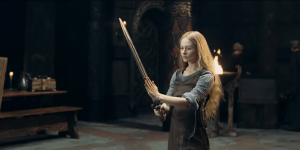
2: Commentary On Gender. Since we’re now on the topic, I feel like we have to talk about this (though I’m well aware that a certain subsection of the Tolkien fandom would rather not). Truth is, you can’t read the tale of The Mariner’s Wife, the most complete extant writing by Tolkien on the Second Age, and not see how it’s a story about gender. I mean, it’s not even subtext. Erendis, the story’s protagonist, literally has an extended, passionate monologue about male privilege and how men will do anything in their power to undermine women, even the great women of history – whose heroic deeds they diminish and leave out of their legends. No matter how much it may cause some people to squirm and start muttering under their breath about “social justice warriors”, I want this entire speech recited onscreen. It’s among the most important and exceptional things Tolkien ever wrote, and it’s true, both in-universe and in real-life. But Amazon shouldn’t stop there: considering what we’ve just discussed about how Númenor’s downfall might have been averted by a woman, I think they could find further opportunities to comment on the empire’s oppressive, patriarchal system.

1: Sexuality. At last we come to it: the great battle of our time. Is sex and sexuality wholly foreign to Tolkien, or is it instead woven subtly and cleverly throughout his work, a thematic goldmine waiting to be properly explored? Both answers are nearly right, in my opinion, but the latter more so. Tolkien’s depictions of sexuality aren’t gratuitous, something I feel the series should reflect, but they’re there: prominently, in the First and Second Ages. For examples, read The Mariner’s Wife (no, but like, seriously, read The Mariner’s Wife: it’s amazing), and you will find that the whole story is bristling with sexual energy. Erendis and her husband have an epic back-and-forth about how he leaves her bed cold, to which he replies that he thought she preferred it that way. Tar-Ancalimë accidentally interrupts a mass wedding and then has to stay the night, listening in embarrassment to the sounds of “merrymaking” all around her as the bridal-chambers are occupied one-by-one. Amazon is going to have to expand on all of this because they’re creating something in a visual medium, but it’s also just common sense to be more explicit rather than less so because it helps to make the existing commentary on gender and sexuality more explicit as well, lending thematic depth to the entire story of Númenor. And for those worried about “the children”…well, I’m honestly not sure you can make a series about the Second Age child-friendly without actually rewriting the entire thing anyway.
So there you have it. Ten examples of things that are either going to shock the Tolkien fandom, or already have (though, to be quite blunt, it seems to be mostly the thought of nudity that has people all riled up: because apparently graphic violence and human sacrifice is fine, but some bare skin is where our fandom draws the line?) It should go without saying that I love the Tolkien fandom, and this isn’t meant as an attack on anyone in particular. So what did you think of my list? Feel free to share your own thoughts, theories and opinions in the comments below – and if you have any more shocking things to add to the list, say so!
